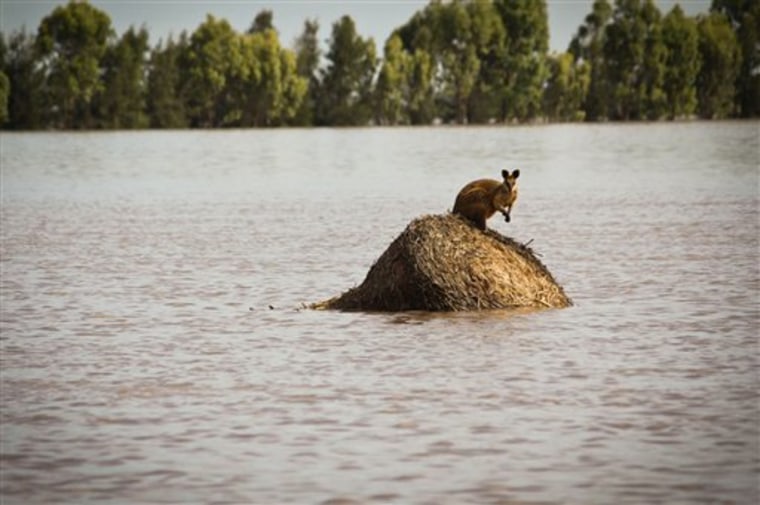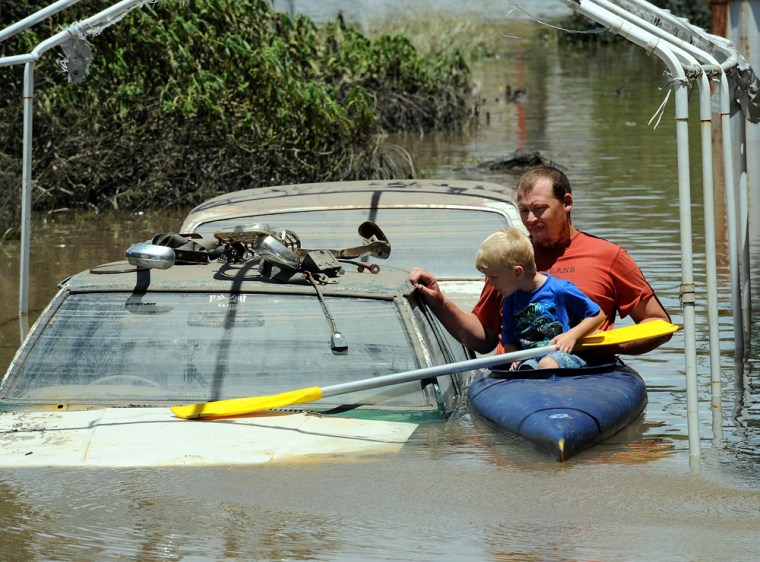Military aircraft dropped supplies to towns cut off by floods in northeastern Australia as the prime minister promised new assistance Friday to the 200,000 people affected by waters. Southern Australia, meanwhile, soaring temperatures and tinder dry conditions have sparked wildfires.
Residents were stocking up on food or evacuating their homes as rising rivers inundated or isolated 22 towns in the state of Queensland.
Authorities warned of rising health risks from floodwaters, along with the danger of crocodiles and snakes in flooded homes.
"This disaster is a long way from over," Queensland Premier Anna Bligh told reporters.
Prime Minister Julia Gillard toured an evacuation center in the flood-stricken town of Bundaberg and announced that families whose homes had been flooded or damaged would be eligible for disaster relief payments of $1,000 per adult and $400 per child.
"My concern is for the people in these very difficult times," Gillard said.
Bundaberg resident Sandy Kiddle told Gillard she lost cherished items when floodwaters surged through her house. She said may not be able to return home for a week.
"It was just a sea of water, and I thought the beach would never come to our house," she told Gillard, who gave her a hug.
The inland sea that now stretches across Queensland is dotted with the roofs of flooded homes, islands of dry ground crowded with stranded livestock and small boats ferrying people and emergency supplies.
Officials say half of Queensland's 715,305 square miles is affected by the relentless flooding, which began last week after days of pounding rain caused swollen rivers to overflow. The flood zone covers an area larger than Texas.
While the rain has stopped, the rivers are still surging to new heights and overflowing into low-lying towns as the water makes its way toward the sea.
The flooding was not expected to reach a peak in some areas until Sunday.
Relief may be more than a week away
The muddy water inundating thousands of homes and businesses has led to a shortage of drinking water and raised fears of mosquito-borne disease.
"This is without a doubt a tragedy on an unprecedented scale," Bligh told Australian Broadcasting Corp.
Bligh warned that drenched communities could be stuck underwater for more than a week, and cleanup efforts were expected to cost billions of dollars.
Supplies of food and bedding were delivered by road and by military aircraft Friday to the towns of Rockhampton, Emerald, Springsure and Blackwater in central-east Queensland.
Northeastern Australia often sees heavy rains and flooding during the Southern Hemisphere summer, but the scope of the damage from the recent downpours is unusual.
The worst flooding in about 50 years has been caused by a "La Nina" weather pattern, which cools waters in the eastern Pacific and has produced torrential rain.
Australia has endured its wettest spring on record, according to the national weather bureau, causing six river systems in Queensland to flood. Swollen rivers in New South Wales state have also caused flood damage to the wheat crop.
The entire population of two towns has already been forced to evacuate as water swamped their communities, cutting off roads and devastating crops. The next city in the water's path — Rockhampton, near the coast — is bracing for flood levels forecast at 31 feet by Monday or Tuesday.
Roads and railway lines were expected to be cut off by Saturday, and the city's airport planned to shut down over the weekend.

"This is a very serious situation," said Rockhampton Mayor Brad Carter, adding that level would affect up to 40 percent of the city. "Police are ordering people in affected areas to leave their homes."
Officials were evacuating residents on Friday, starting with the elderly and those living in low-lying areas.
There were concerns over food supplies in the city, with many stores already sold out of bread, milk and fresh meat, Carter said.
Gary Boyer, regional manager of supermarket chain Woolworths, said the company was sending 43 trucks full of supplies into Rockhampton on Friday.
Thousands of people have been evacuated from their homes this week. In the central Queensland town of Emerald, about 1,000 people were evacuated in the last 24 hours.
The town was facing food shortages, power outages and sewage-contaminated floodwaters, county mayor Peter Maguire said. Three evacuation centers have been set up to help displaced residents.
Fire danger in south
In the southern states of Victoria and South Australia, meanwhile, authorities warned of possible "catastrophic" fires if conditions worsened and holiday travelers were asked to prepare evacuation plans.
"We're asking people to have a plan, how they're going to get to where they're going ... a plan to get away ... if a bushfire happens to threaten," said South Australia rural fire chief Andrew Lawson.
Firefighters, helped by cooler temperatures, contained small fires late on Friday, but meteorologists said readings could soar again above 104 degrees Fahrenheit in the next few days.
